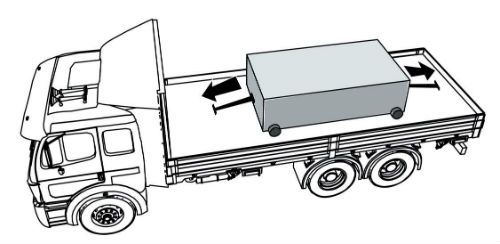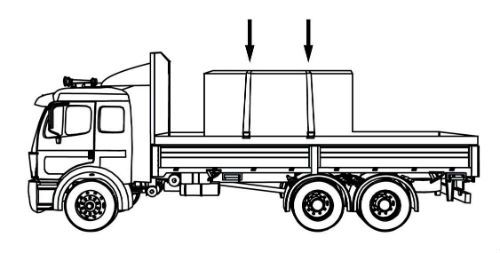CDL Practice Tests: Flatbed Cargo Securement
Choose A Section:
Go!The North American Cargo Securement Standard cover vehicles weighing:
- Over 4,500 lbs
- Less than 10,000 lbs
- Over 10,000 lbs
- 26,001 lbs
North American Cargo Securement Standard
What does the Standard cover? (Section 1.1)
- Commercial vehicles (including a combination of vehicles) that are operated on a highway and have a gross vehicle rating over 4,500 kg (10,000 lb.)
Vehicles
Working Load Limit (WLL)is defined as:
- The number of hours that a tiedown can be used.
- The acceleration due to gravity, 9.823 m/sec2 (32.2 ft/sec2).
- The maximum load that may be applied to a component of a cargo securement system during normal service, usually assigned by the manufacturer of the component.
- The summation of the working load limits or restraining capacity of all devices used to secure an article on a vehicle.
Working Load Limit (WLL):
The maximum load that may be applied to a component of a cargo securement system during normal service, usually assigned by the manufacturer of the component.
Option #3 for securing metal coils transported with eyes lengthwise includes all of the following except:
- Attaching at least two tiedowns through the center of the coil.
- Attaching at least one tiedown over the top of the coil near the front of the coil.
- Using blocking or friction mats to prevent forward movement.
- Attaching at least one tiedown over the top of the coil near the rear of the coil.
Tiedowns, Single Coil Option #3
Option #3 is the same as Options #1 and #2, except that the two tiedowns that attach through the eye of the coil are replaced with two tiedowns that pass over the front and the rear of the coil.

Attach at least one tiedown over the top of the coil near the front of the coil.
Attach at least one tiedown over the top of the coil near the rear of the coil.
Use blocking or friction mats to prevent forward movement.
When securing building materials, spacer requirements include all of the following except:
- If spacers are comprised of layers of material, the layers must be unitized or fastened together to ensure that the spacer performs as a single piece of material.
- Spacers must provide good interlayer friction.
- The length of spacers must provide support to all pieces in the bottom row of the bundle.
- The height of each spacer must be equal or greater than the width.
Spacer Requirements
- The length of spacers must provide support to all pieces in the bottom row of the bundle.
- The width of each spacer must be equal or greater than the height.
- Spacers must provide good interlayer friction.
- If spacers are comprised of layers of material, the layers must be unitized or fastened together to ensure that the spacer performs as a single piece of material.
When securing paper rolls with eyes horizontal, which of the following should be used to secure the rear-most roll?
- Secure blocking against rear doors.
- Wedges or chocks secured by some means in addition to friction.
- Secure roll against rear doors.
- All of these are acceptable

Note: Chocks, Wedges, or Blocking Securing the Front or Rear Roll - Hold in place by some means in addition to friction so they cannot become unintentionally unfastened or loose while the vehicle is in transit. This is often accomplished with nails.
Requirements for eyes crosswise: secure rearmost roll
Do not secure the rearmost roll with:
- Either the rear doors of the vehicle or intermodal container
- Or blocking held in place by those doors.
What types of freight need to be secured properly?
- Hazardous materials.
- All freight should always be properly secured while driving.
- Equipment used for vehicle operation.
- Intermodal containers.
-
Any cargo and dangerous goods/hazardous materials, including:
- All general freight.
- All equipment carried for vehicle operation.
- Intermodal containers and their contents.
- Some specific commodities have additional or different securement requirements (see later sections of this Handbook).
- Additional requirements under separate regulations may also apply for transportation of certain types of dangerous goods or hazardous materials.
Cargo
What is bell pipe concrete?
- Pipe whose flanged end is of smaller diameter than its barrel.
- Concrete used to make bell pipe.
- Pipe whose flanged end is of larger diameter than its barrel.
- Pipe used to make concrete bells.
Bell Pipe Concrete:
Pipe whose flanged end is of larger diameter than its barrel.
An intermodal container is:
- A reusable, transportable enclosure that is especially designed with integral locking devices that secure it to a container chassis trailer to facilitate the efficient and bulk shipping and transfer of goods by, or between various modes of transport, such as highway, rail, sea, and air.
- A specialized container, primarily used to contain and transport materials in the waste, recycling, construction/demolition, and scrap industries, which are used in conjunction with specialized vehicles, in which the container isloaded and unloaded onto a tilt frame body by an articulating hook-arm.
- A platform or tray on which cargo is placed so that it can be handled as an article. (Same as "Skid")
- A vehicle especially built and fitted with locking devices for transport.
Intermodal Container:
A reusable, transportable enclosure that is especially designed with integral locking devices that secure it to a container chassis trailer to facilitate the efficient and bulk shipping and transfer of goods by, or between various modes of transport, such as highway, rail, sea, and air.
Methods of securing building materials against forward motion include:
- These are all valid methods.
- Using tiedowns.
- Employing blocking equipment.
- Placing bundles against the bulkhead or front end.

-
Option #1
Place bundles against bulkhead/front end structure.
-
Option #2
When different tiers need to be secured, use a combination of blocking equipment and tiedowns.
When using tiedowns to secure boulders, all of the following are requirements except:
- Tiedowns must be arranged to prevent sliding across the rock surface.
- Boulders must be loaded as far back towards the rear as possible.
- Use only chain to secure large boulders.
- Tiedowns should be located in valleys or notches across the top of the boulder.
Requirements

Use only chain to secure large boulders.
Tiedowns in direct contact with the boulder:

Should be located in valleys or notches across the top of the boulder
Must be arranged to prevent sliding across the rock surface.
About The Flatbed Cargo Securement CDL Manual
Studying the flatbed cargo securement CDL manual is not a requirement for getting your CDL permit or license. It is required knowledge for flatbed drivers.
Some questions you should be able to answer for flatbed cargo securement:
- What is the minimum Working Load Limit of a tiedown used to secure logs?
- What is the minimum weight of a shipment of paper rolls that would require specific securement requirements?
- When securing concrete pipe over 45 inches loaded crosswise, which direction must the tiedowns on the front half of the load run?
- What is a cab shield?
- When securing concrete pipe over 45 inches loaded crosswise, which direction must the tiedowns on the rear half of the load run?
- What is a dunnage bag?
- Who is responsible for inspecting securing devices and cargo within the first 50 miles?
- How many tiedowns are required on a stack of shortwood loaded crosswise?
- What is the minimum working load limit of each tiedown used to secure crushed or flattened vehicles?
- Define 'bolster'
- What is a hook-lift container?
- When a tiedown is attached directly to the cargo, what is the ideal angle where it attached to the vehicle?
What is a securing device?
Any device specifically manufactured to attach or secure cargo to a vehicle or trailer:
- Synthetic Webbing
- Chain
- Wire rope
- Manila rope
- Synthetic rope
- Steel strapping
- Clamps and latches
- Blocking
- Front-end structure
- Grab hooks
- Binders
- Shackles
- Winches
- Stake pockets
- D-rings
- Webbing ratchet
- Bracing
- Friction mat
What is a tiedown?
A combination of securing devices that forms an assembly that:
- Attaches cargo to, or restrains cargo on a vehicle.
- Is attached to anchor point(s).

Some tiedowns are attached to the cargo and provide direct resistance to restrain the cargo from movement.

Some tie-downs pass over or through the cargo. They create a downward force that increases the effect of friction between the cargo and the deck. This friction restrains the cargo.
 Related Cargo Securement Terms That Every Driver Should Know:
Related Cargo Securement Terms That Every Driver Should Know:
-
Tiedown:
A combination of securing devices which form an assembly that attaches cargo to, or restrains cargo on, a vehicle or trailer, and is attached to anchor point(s).
-
Contained:
Cargo is contained if it fills a sided vehicle, and every article is in contact with or sufficiently close to a wall or other articles so that it cannot shift or tip if those other articles are also unable to shift or tip.
-
Blocking:
A structure, device, or another substantial article placed against or around an article to prevent horizontal movement of the article.
How should tiedowns be attached?
Tiedowns can be used in two ways:
-
Attached to the cargo:
- Tiedowns attached to the vehicle and attached to the cargo.
- Tiedowns attached to the vehicle, pass through or aroundan article of cargo, and then are attached to the vehicle again.
-
Pass over the cargo:
- Tiedowns attached to the vehicle, passed over the cargo, and then attached to the vehicle again.
Tiedown placement:

Place the tiedown as close as possible to the spacer.
Position the tiedowns as symetrically as possible over the length of the article.

Position the tiedowns to preserve the integrity of the article.







 TT On Facebook
TT On Facebook